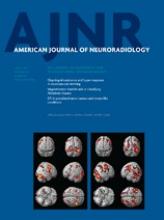Table of Contents
Editorials
Perspectives
Editorials
Review Articles
Expedited Publication
- Clopidogrel Hyper-Response and Bleeding Risk in Neurointerventional Procedures
Patients may respond to antiplatelet medication in 2 ways: resistance leading to higher incidence of ischemic events and hyper-response resulting in bleeds. Here, 47 patients treated with clopidogrel were tested for P2Y12 receptor-mediated platelet inhibition. Clopidogrel hyper-response was more common in patients with major (n=10) than in those with minor bleeds. Of 7 patients defined as hyper-responders, 43% had major bleeding complications. Thus, hyper-response to clopidogrel is associated with increased risk of major hemorrhage. (See the related article by Comin and Kallmes.)
Patient Safety
Practice Perspectives
- Neuroradiology Critical Findings Lists: Survey of Neuroradiology Training Programs
These authors questioned neuroradiology fellowship programs about the availability of “critical findings” lists and, if available, how these are distributed to trainees and whether they were vetted by corresponding clinical departments. Over one-half of programs responded and 41% had such lists. The lists were distributed during orientation, sent or made available electronically, and posted in work areas. Less than 25% of lists were developed with input from other departments. The most common entities found in the lists were: brain hemorrhage, acute stroke, cord compression, brain herniation, and spine fracture.
Brain
- Traumatic Intracranial Hematomas: Prognostic Value of Contrast Extravasation
Contrast extravasation in hematomas predicts their growth and thus these authors assessed the prognostic value of this sign. Sixty patients with cerebral hematomas received CTA and/or perfusion CT within 24 hours of admission and then a follow-up CT at 72 hours. Fifty percent of patients showed contrast extravasation and this finding predicted poor in-hospital outcome. Recognition of contrast extravasation achieved a near perfect interobserver agreement.
Functional
- Anatomic MR Imaging and Functional Diffusion Tensor Imaging of Peripheral Nerve Tumors and Tumorlike Conditions
In this study 29 patients underwent anatomic and functional imaging (DWI and DTI) of peripheral nerve masses in an attempt to improve their characterization. ADC values were lower in malignant tumors, the involved nerves had lower fractional anisotropy, and DTI showed differences between benign and malignant tumors. The authors concluded that tractography and fractional anisotropy provide insight into neural integrity while low diffusivity indicates malignancy.
Interventional
- Diagnostic Yield of Catheter Angiography in Patients with Subarachnoid Hemorrhage and Negative Initial Noninvasive Neurovascular Examinations
These authors explored the diagnostic yield of DSA in patients with SAH and previously negative CTA or MRA. A total of 55 patients who presented with diffuse SAH, perimesencephalic SAH, or sulcal SAH received CTA (n= 47) or MRA (n= 8). Despite normal findings on CTA or MRA, DSA showed vascular lesions in 11% of patients with diffuse SAH and in 1 patient with sulcal SAH. The investigators concluded that DSA is a valuable tool in patients with diffuse or sulcal SAH in whom previous noninvasive examinations are negative.
Commentary
Extracranial Vascular
Head & Neck
Pediatrics
Spine
- Screening Cervical Spine CT in the Emergency Department, Phase 2: A Prospective Assessment of Use
Here, the number of unnecessary CT cervical studies despite proper application of NEXUS criteria was assessed. The authors also tried to determine indications for ordering studies in the absence of guideline criteria. Of 507 CT studies, only 5 (1%) were positive while 81 of the 502 patients with negative findings (16%) were imaged despite meeting all NEXUS criteria for non-imaging. The most common indications for the studies were a dangerous mechanism of injury and subjective neck pain. Strict application of NEXUS criteria may result in considerable reduction of screening CT studies of the cervical spine.








